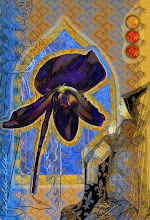
Here is a better view of the flowers. They remind me of an old-time villain with a handlebar moustache. I'm sure the shape has evolved as a way to attract pollinating insects. Those long petals must really sway in the breeze.

And here is a single flower. They are really large, and have a very complex structure.

In profile, the flower looks quite alien, like some strange insect leg was grafted onto a flower.

One fine detail of the petals is that they have tiny black hairs going off in various directions. Right-sized to be noticed by small insects, even if they are a bit tricky for us humans to notice (and photograph).

Lastly, here is part of the flower where you can clearly see the pollen. In the center of the photo, notice a small oval structure with a red-orange rim. That is the pollen. Normally, an insect climbs into the flower pouch, which has a very waxy inner surface. Because of the small opening, the insect cannot easily fly out. The only method of egress is to climb up the rear inside surface of the pouch, which is rough, and not waxy. That path first takes the insect past the female part of the flower, the stigma. Then as the insect climbs higher, it passes the pollen, which adheres to the body of the insect. When said insect visits the next flower, the pollen is likely to be transferred to the stigma of that new flower. In this way, the orchid makes it much more likely that it will not be self-fertilized, thus improving the gene pool. Really a remarkable flower!












